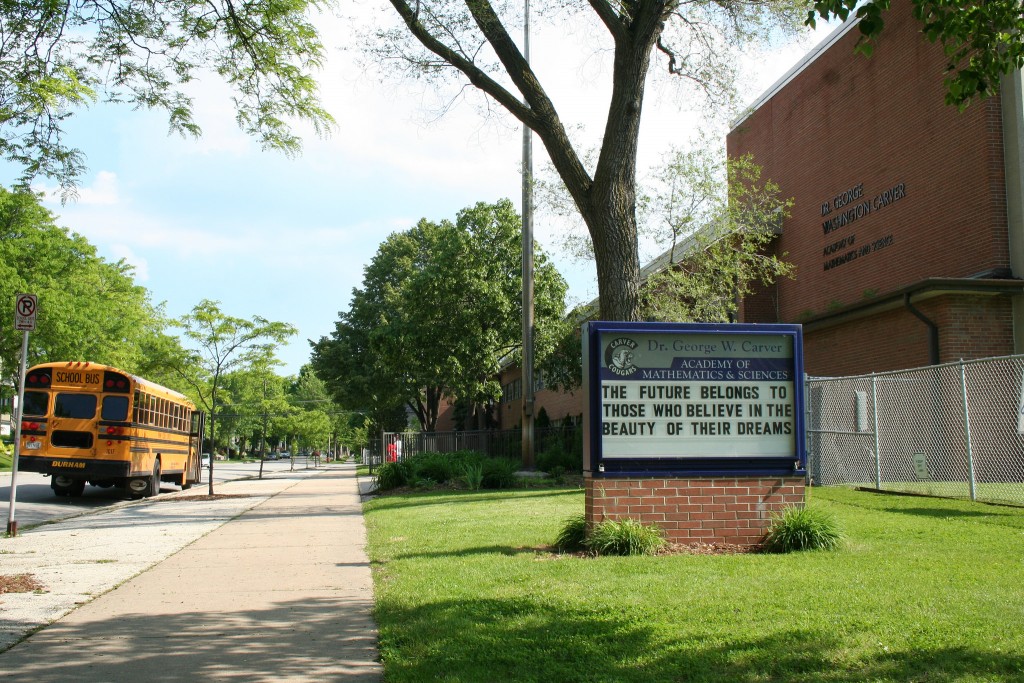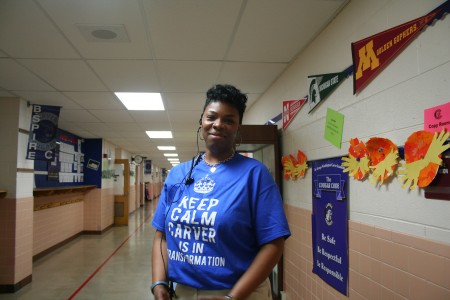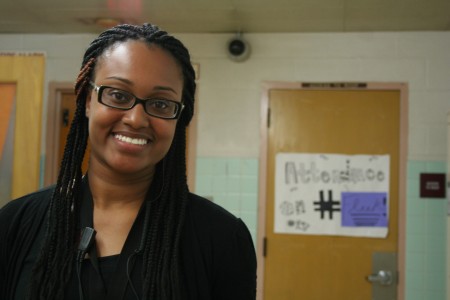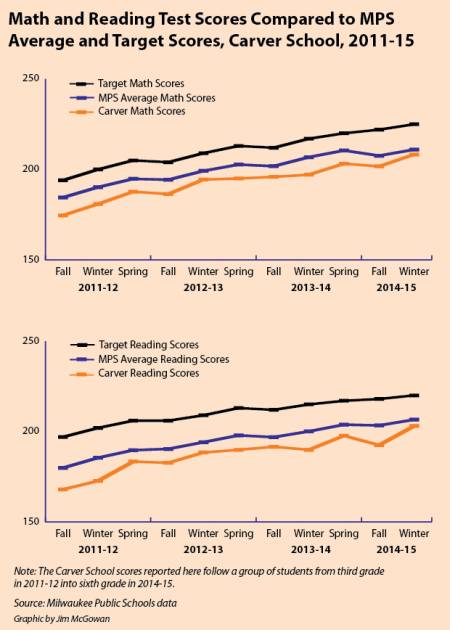MPS and Non-Profits Teamed Up to Rescue Carver Academy
School that was failing "by every measure" is now changing its culture.

George Washington Carver Academy of Math and Science, 1900 N. 1st St. in Brewers’ Hill. Photo by Jabril Faraj.
On an overcast spring morning, students enter George Washington Carver Academy of Math and Science to the sound of old-school hip-hop playing through the PA system. They walk in the main entrance past a poster of the school’s namesake. The meaning of the quote displayed under Carver’s photo is simple; it reads, “Where there is no vision, there is no hope.”
Four years ago, Carver Academy was at a breaking point. Milwaukee School Board of Directors at-large member Terry Falk said the school was failing “by every measure” — student achievement was dismally low, few neighborhood families attended Carver and high student turnover plagued the school. Suspensions were high — almost half of the student body was suspended at least once — and attendance was lower than the district average.
In July 2011, the board announced that a new principal, Jacqueline Jolly, would take over the school at 1900 N. 1st St. in Brewers’ Hill. In 2011-12 suspensions skyrocketed. The percentage of students suspended at least once rose 10 percentage points in a year suspensions dropped district-wide. In fall of that same year then-Milwaukee Public Schools (MPS) superintendent Gregory Thornton recommended closing the school and expanding the high-performing Maryland Avenue Montessori School program into the building. Carver and Maryland Avenue would function as one school with the upper grades in the Carver building.

Janel Hawkins stands outside the office at Carver Academy, where she will be going into her fourth year as principal. Photo by Jabril Faraj.
The middle-income Maryland Avenue parents and the largely African-American low-income Carver parents resisted. Instead, the school board, “decided to give Principal Jolly a chance to turn the school around,” said Falk. The board voted to freeze enrollment and open the school as an MPS charter school in 2013-2014.
That decision stood until May 2012, when the board voted to reestablish Carver as a traditional public school. In July 2012, Jolly was replaced by Janel Hawkins, who previously served for 10 years as the principal of MPS’s Seifert Elementary. In Hawkins’ first year, suspensions fell slightly, compared to a nearly 5 percentage point drop across MPS. Student growth scores, which measure how much students learn from year to year, had been on par with the state average the year before but dropped dramatically — by nearly 13 percent — in the 2012 school year.
“We’ve had a lot of challenges,” said Melinda Laster, a fourth-grade teacher who has taught at Carver since 1999. Laster’s class has consistently seen high-quality academic results even while Carver has struggled.
That’s when leaders of three nonprofit organizations who were already working in MPS had an idea: what if they all worked together at one school with the goal of accomplishing a list of shared objectives? The executive directors of City Year Milwaukee, Teach For America (TFA) Milwaukee and Schools That Can Milwaukee (STC) came together and approached the Northwestern Mutual Foundation, which had previously funded all three organizations.
Irissol Arce, a program officer in Strategic Philanthropy and Community Relations at Northwestern Mutual, said the collaboration appealed to the foundation because it could “potentially be something that could be replicated and scalable.”
“They’re not [in] one of our focus neighborhoods but we definitely just saw this as an area where we thought there could be some positive things happening … and we thought that we really needed to step up,” she said.
The unprecedented collaboration sought to pull all five organizations together to improve academic performance. Northwestern Mutual would fund the initiative, STC would coach administrative staff, TFA would provide teacher support and City Year would give classroom and teacher support, with MPS determining a strategic vision and allocating additional resources. The organizations’ roles were similar to their work in other schools but the shared vision was entirely new.
By many accounts, even at the beginning of the 2013-2014 school year, the collaboration’s first year, the atmosphere at Carver was loud and disruptive — an environment that wasn’t conducive to learning.
On this spring morning, though, there isn’t a peep out of the students who walk single file into the school’s gymnasium for morning assembly. The gathering, which lasts for about 35 minutes on Tuesday and Thursday mornings, is a cornerstone of the new Carver.

Tianna McCullough, Carver Academy’s Instructional Coach for Culture, says the school’s culture had to change. Photo by Jabril Faraj.
To turn Carver around, the school’s culture had to change, said Instructional Coach for Culture Tianna McCullough.
To that end, the school started “by having very clear expectations for what hallway movement looks like,” said McCullough. Those expectations include walking single-file on lines taped onto the hallway floors while maintaining noise at “level zero.” Children walk with arms crossed or at their sides and their mouths closed; the little children call the practice “hugs and bubbles.” Staff said the regimen, along with the practice of “self-contained” classes — students spend their entire day in a single classroom — has helped to decrease disturbances and has made it easier to build relationships with students. Students are outside of their designated classrooms for the bi-weekly assemblies and for 45 minutes of art instruction weekly.
“I have the same group of kids from 8:50 to 3:45. I love being self-contained because I think it’s so much easier to build a strong classroom culture,” said second-year TFA teacher Catherine Cwirla. “My first year, the very beginning was a little rocky.”
“Kids were just defiant, every day,” added Hawkins.
“Last year, we used to always stay (in the hallways) talking or somebody would get into it or start fighting,” said sixth-grader Latesha Davis. “This year, we didn’t have any fights but a couple.”
The new Carver
On this particular morning, most of the students are already in the gym, seated in sections divided by classroom. The classrooms are named after traditionally black colleges and universities — Morehouse, Howard, Clark Atlanta and Hampton are just a few. The classroom names are part of a focus on success and achievement; school leaders hope that exposure to the possibilities of later life will inspire the students to take ownership of their education.
Hawkins said staff, students and parents have “been having a lot of conversations about high school and college.”
“Our aim is to get our kids to college and career readiness,” said McCullough. “But the reality is we have kids that come to us and kids that are here in this building that are two and three grade levels behind. So, there’s a lot of work in … closing that achievement gap for our scholars,” the term staff and faculty use to describe the students.
About a third of Carver’s 450 students sit on the gym floor, cross-legged; a couple students hold hand-written signs that read “excellence” and “perseverance.” More than 95 percent of Carver students are African-American and about the same number are economically disadvantaged.
The seated students are surrounded by teachers and City Year corps members who stand, observing. Of the 22 adults in the room, 14 are black or mixed-race. Most are engaged in the assembly, watching Hawkins as she starts the event.
Hawkins begins with a call of, “Good morning, Carver!” The students respond with a less-than-enthusiastic, “Good morning, Ms. Hawkins.” They repeat the exchange once more until the students are loud enough. Then another chant: “Students, are you ready?” “We ready!” “Teachers, are you ready?” “We ready!”
Staff members are intentional about trying to increase what Hawkins and McCullough called the “joy factor.” Playing music when students enter the building, making sure staff and faculty are actively engaging students, even holding pep rallies before tests — they’re all new tactics the school has embraced.
“We talk a lot about joy,” said Hawkins, adding that she wants Carver to be a place where children and adults want to come.
At the assembly, Hawkins plugs the upcoming MAP (Measures of Academic Progress) test pep rally. “You don’t want to miss it,” she says. The mood in the room seems split; one student mutters, “I do.”
“We’re going to pull on some of the emotional strings,” Hawkins said in an interview, referring to the rally. “We want to get kids excited about [the test].”
Student progress — showing the ability to close gaps between target and actual scores on the MAP test — is the primary indicator of success in Carver’s transformation. Cheryl Baldwin, one of two UWM researchers working to measure the effectiveness of the Carver collaboration, said student MAP scores are an objective assessment of progress.
“When a school is well-structured, when teachers are effective in student engagement … that’s when learning will happen,” Baldwin said.
The MAP test, which is taken three times a year, in fall, winter and spring, provides a look at how Carver is faring. Hawkins said staff and faculty are trying to provide students with a “good testing environment” and motivation, factors that she cited as having a positive effect on test performance.
Laster, who gives constant encouragement in the classroom, said her students’ excitement for a particular test comes from the knowledge that they are able to do the work they’re being tested on. Laster often uses hands-on methods — for example, teaching math with manipulatives — because she acknowledged that some children “need a different strategy” to understand certain material.
“You have to let them have hope in themselves and believe in themselves that they can do it,” she said.
By the numbers
Hope had largely been lacking at Carver in recent years. The school scored 22.2 out of 100 in student achievement on Wisconsin DPI’s school report card in 2011-2012. There were changes in the report card over the next two years, including alignment with Common Core standards; the score dropped to 19.2 in 2012-2013 and 16 in 2013-14, when the state average was 67.1.
Carver’s MAP scores since the 2011-2012 school year have been marked by inconsistency. Many of the school’s end-of-year gains have been tempered by drops the following fall, after summer vacation. For example, toward the end of 2011-2012, the school seemed to be making gains, with almost every grade level closing gaps between actual and target scores in reading achievement and four of the nine grades making significant progress in math scores. But in fall 2012-2013, the achievement gaps for all but a few grade levels had widened in both subject areas and the slide continued into the spring.
“That first year … [we] kind of muddled through some things, second year is when the partnership came in (and) we actually developed a clear mission and vision that we created with the staff,” Hawkins said, noting that “80 percent of existing teachers left after that first year.”
Hawkins attributed the exodus to low morale but said the upheaval wasn’t necessarily a negative. “It signaled a starting-over,” she said. “I really count last year (2013-2014) as our first year of transformation.”
Reading has been the crux of the school’s challenges. In addition to the collaborative efforts, the school was named an MPS Commitment School, along with 13 other struggling campuses. Those schools received “additional instructional support, professional development and operational assistance” from MPS over the course of the 2014-2015 school year. This commitment provided Carver with a “reading interventionist” and a “student support teacher.”
Leni Dietrich, leadership development coach at Schools That Can, stated that Carver’s reading scores are “probably [some] of the lowest in the district.” For this reason, in its second year the collaboration has focused on reading, instituting a phonics program for younger children, investing in “leveled libraries,” which mark books by color depending on reading level, and creating a summer reading program.
“If you want kids to be excited about learning, you have to give them good things to read … and you have to give kids books that are at their reading level,” Dietrich said.
Carver is also focusing on increasing attendance and reducing suspensions to improve achievement.
Having students in the classroom consistently is absolutely necessary for academic improvement, said Angela Kaper, a sixth-grade teacher in her second year at Carver. “Attendance is the base; we have to have our kids here.”
In 2012-2013, Carver’s attendance rate was 88.9 percent, just below the MPS average but significantly lower than high-performing schools such as Maryland Avenue, which has an average above 95 percent. In 2013-2014, the collaboration’s first year, Carver’s attendance fell to 86.8 while the district average rose slightly. Hawkins said Carver’s goal is that 95 percent mark.
The school’s suspension statistics are more problematic. Between 2009 and 2011, Carver’s suspension percentage hovered near 50. The statistic measures what percentage of the student body was suspended at least once. In 2009-2010, the MPS average was almost 30 percent but, over the next three years, that figure fell more than 12 percentage points to 17.4.
In 2011-2012, Carver’s suspension rate jumped to more than 55 percent. During that year, 303 of the school’s 546 students were suspended; those students missed an average of 6.1 days. The following year, Hawkins’ first, suspensions stayed about the same with each suspended student missing an average of 6.3 days. MPS officials have said, in respect to suspensions at Carver, “the trend of significant decline continued” in 2013-2014 but Wisconsin DPI has yet to publish suspension statistics for 2013-2014 and 2014-2015.
Creating a culture
Hawkins said she is encouraged that students have begun to understand the expectations she and others have for them. She cited a situation where a student was about to be suspended, but he came to her and said, “‘Ms. Hawkins, you know, we probably should talk about this because you want me here and so the suspension might not be the best thing, right now.’
“So, we had that conversation. Kids are paying attention — they know we need them here,” she said.
The Carver administration has been very intentional about defining what kind of culture it wants. Toward the end of the Thursday morning assembly, McCullough launched into a story about a fifth-grader from Milwaukee French Immersion School who was a model student until one day on the bus when another student taunted the girl, calling her “four eyes.” Her coke-bottle glasses were a sensitive topic; she dared him to say it again. He did and she hit the boy.
The young girl was, in fact, McCullough. “I lost my cool and it’s something that stuck with me,” she said.
“Had I paused in that moment … that could have changed the outcome of that situation,” said McCullough. “When you’re … in a tough situation, it’s easy to just react off of your impulses, to react off of your emotion.”
The Carver staff emphasizes core values — in announcements, in assemblies, in counseling sessions and throughout the day. Every day, they stress the values of belief, stewardship, perseverance, integrity, respect and excellence (BSPIRE).
“No excuses!” The students chant together at the assembly. “We work hard to get smart to go to college!” This time, they’re loud enough the first time.
“We want a culture of excellence,” McCullough said. “We want a culture where our students are not only exposed to academic rigor … but also that character piece. We are preparing them to be the citizens of tomorrow, the leaders of tomorrow.”
McCullough, who is in her second year, spearheaded the creation of a “choice management system” at Carver that tells students that they “are able to make choices.” They system is based on a “token economy” in which students get “deposits” when they make positive choices and are issued deductions when they make negative choices. Students must accumulate a certain number of points to achieve specific incentives, including participating in field trips or dances, or getting privileges such as unlimited bathroom access.
“Within that choice management system is a whole system of … consequences if there is a breach to culture,” said McCullough.
One of those consequences might be a one-on-one meeting with McCullough, Hawkins or Assistant Principal Kristin Hinds, a time out or staying in an administrator’s office for the day. “It just [depends] on what the infraction was,” Hawkins said.
Even though the staff is looking for alternatives to suspension, there are certain lines that can’t be crossed, added McCullough. “If you are being unsafe, if you are putting yourself, other students or teachers in danger because of your behavior, then that is a point where we are beyond, ‘Let’s have a conversation about that.’”
At that point, she said, the administration would work with that family “to develop an action plan … to better support that student, moving forward.”
Building relationships
For some students, the changes have made a difference. Damien Harris is a sixth grader who Hawkins said “was suspended quite a bit last year.” Damien has been at Carver for eight or nine years and said he used to put hot towels on his head to act like he was sick so he wouldn’t have to come to school. Now, after a visit with a counselor and an understanding of what school will mean for his future, he says he likes school and will miss it over the summer.
“When I learn … it excites me,” said Damien. “I know that it’s … a ticket to my success.”
Latesha Davis, who came to Carver two years ago after attending Browning Middle School, said she was always getting suspended for things like fighting, spitting on people and throwing people’s clothes in the toilet.
“I started doing all my work, I didn’t have no fights this year,” she said. Latesha said she didn’t get a single suspension this year and she doesn’t run in the halls anymore.
On the other hand, Lauretta Warren’s 6-year-old son has been suspended “four or five times,” for crying and being rowdy, according to the single mother. She said she’s asked for a meeting with Hawkins but hasn’t gotten the help she’s looking for. Her son, who is in kindergarten, came to Carver early in 2015 with his sister after a run-in with a teacher at his previous school. Warren went to the school board and an investigation followed; nothing was found and the boy was transferred.
“I want help for him — that’s my baby,” said Warren.” I don’t want it to be like this the rest of his life, getting kicked out of school or … whatever the case may be.”
Hawkins said she had no recollection of speaking with Warren and that “quite a few” children the boy’s age had been suspended multiple times. Student privacy policies prohibit MPS from commenting on individual disciplinary situations.
The challenges some students face in school can be exacerbated by conditions at home or in their neighborhood. Angela Meadows, a program manager for City Year, said the type of “trauma situations” that Carver students encounter “runs the gamut,” including homelessness, domestic violence and gun violence.
“Without a relationship, people just aren’t as likely to care what it is that you have to say or what you think if you aren’t showing that you’re just as interested in them as a human being,” Meadows said.
She said it’s important to approach difficult situations with students with the understanding that “there’s something deeper going on” and to “not assume that it’s an attack on you as a person.” For many students, that’s the difference between success and failure.
Kate Tindle is a government education consultant and board chair of Teaching for Change, a nonprofit organization whose mission is to build social justice. Tindle said strong, positive relationships between students and adults are “the number one thing” that made a difference in schools, particularly “high needs” urban environments, such as Carver.
“One of the things that we work really hard at is building those relationships,” said Hawkins, adding that since students come from all over, creating a sense of community at the school is important.
Latesha said she and her teacher, Ms. Kaper, have “good talks,” which she says make her feel special. “Knowing that my teacher’s got faith in me, that makes me want to come to school every day,” she said. “When I’m off, she’ll try to talk to me to get me back together and she won’t give up on me.”
Kaper, who has taught everywhere from juvenile detention centers to choice schools, always seems to be in high gear. She believes “teaching is in your soul” and that “you have these children’s lives in your hand.” For that reason, she pushes her kids — and herself — every day.
“I let my kids know, and any kid I come in contact with … I believe in you. And, once they know that someone believes in them and tells them they can succeed and gives them the possibility and the tools to succeed … they’re gonna fly.”
“Not every child is given the same opportunities,” said Kaper. “It’s not fair. And, my kids in this house (Carver) are just as important as any other child.”
“So, my goal … is to help the kids that aren’t given the opportunity that everyone else is and give them 150 percent of myself,” she said.
“Seeing how Ms. Kaper teaches, it just makes me want to be a teacher,” Latesha said, who added that every time she helps younger students, her confidence in her ability grows. “I stopped doing what other people do and started being myself.”
Hawkins said the school has made some gains but is “by no means” ready to call the effort a success. “I think, when we can show some consistency over time, then that’s when we’ll really raise the flag and say we’ve declared victory,” she said.
Northwestern Mutual has scaled back investment by 35 percent since the collaboration’s first year at Carver. Arce said that the partners informally acknowledged at the outset that the collaboration would need “at least three years” but she added, “We don’t want to step away from Carver until we really know that they’re sustainable and that the partnerships are sustainable.”
Representatives of all the partner organizations affirmed their commitment, moving forward. TFA is determined to see the work succeed, said Milwaukee Executive Director Garrett Bucks. “We’ll be there until Carver is one of the strongest schools in the city.”
This story was originally published by Milwaukee Neighborhood News Service, where you can find other stories reporting on fifteen city neighborhoods in Milwaukee.


















Great start…As you continue to prepare these students for the rest of their lives, don’t forget the verbs.